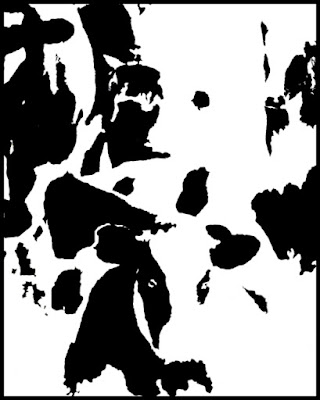Take a look at today's image. What do you see? Is it just a random splash of black ink on a white page, or are there cows standing in a group? Have you ever gone out shooting with friends and then chimped each other's shots over a beer? Whenever I do, invariably an image pops up and everyone other than the person who took the shot says "where'd you shot that?". Each of us typically swears that the shot wasn't anywhere that we were shooting at. None of us saw that view, angle, entire scene, or colors or something. Of course, the rest of us were almost shoulder to shoulder, in lockstep with the cameras all aimed in the same direction. Someone (or ones) were the creative folks and looked in a different direction. It could be up, down, sideways or back from whence we came, but there's something unique about a few of the images out of the entirety of the shoot. The more we get together, the more I can identify the individuals who'll come up with the shots the rest of us pass by. Out of a group of twenty or so, it's the same couple of people who see things in a way that escapes the rest of us. There are things that are visible about these folks. If it's a winter shoot, everybody else is wearing a parka, mukluks, mittens, a ski cap and obviously thirty seven layers of clothes. The ones who get the most unique shots wear a cape, that's it. We're out to battle the elements, they're out to experience the day. They think different. They're "wired" unlike any of the rest of us. They're creative. To find the answer to what today's image is all about, hit the "read more".
It's cows. Specifically, three cows. It pays homage to Otto Litzal. He had a book published back in 1967 titled "Darkroom Magic". It was back in the dark ages of photography when people actually used film in their cameras. Otto did some of the same "creative" things you see today. The big difference is that today it means pushing a button. In Otto's time it meant understanding what was going on between the click of the shutter and the final print. It meant using the right media and the correct chemicals to get an end result. Otto's creativity came from knowledge, not from pushing buttons. Not that pushing buttons is a bad thing. I do it all the time. The trick is not to be surprised at the outcome.
Try taking a Curves Adjustment Layer and make it look like an up pointing arrow. Use the "pen" found on a Curves Adjustment Layer and click on the lower left corner. Holding the Shift key down, click at the midpoint at the upper center point. Keep the Shift key down and click on the lower right corner. You just solarized your image. If you have someone only familiar with a digital darkroom they'll probably suggest that you didn't matchup the images to eliminate the fringing. The thing is, that "fringed" look is necessary for a true solarized effect. The "fringe" is called "Mackie Lines" and they're supposed to be there. It's what makes the solarization effect.
"Seeing" what you're looking at is a developed habit. Good photographers look through the viewfinder and see the entire scene. The difference between a good photographer and someone new to shooting is what's in the background of the image.






0 comments:
Post a Comment